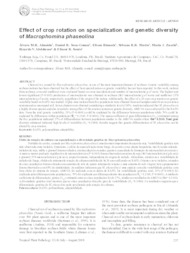Effect of crop rotation on specialization and genetic diversity of Macrophomina phaseolina.
Effect of crop rotation on specialization and genetic diversity of Macrophomina phaseolina.
Autoria: ALMEIDA, A. M. R.; SOSA-GOMEZ, D. R.; BINNECK, E.; MARIN, S. R. R.; ZUCCHI, M. I. ABDELNOOR, R. V.; SOUTO, E. R.
Resumo: Charcoal rot, caused by Macrophomina phaseolina, is one of the most important diseases of soybean. Genetic variability among soybean isolates has been observed but the effect of host specialization on genetic variability has not been reported. In this work, isolates from soybean, corn and sunflower were evaluated based on cross inoculations and number of microsclerotia/g of roots. The highest and lowest significant (P<0.005) production of microsclerotia was obtained in soybean (863 microsclerotia/g of roots) and sunflower (578 microsclerotia/g of roots), respectively, regardless of the origin of the isolate. Additionally, the effect of a 20-year crop rotation on genetic variability based on RAPD was studied. Eighty-nine isolates from five populations were obtained from soil samples under four crop rotation systems and an uncropped soil. Seven clusters were obtained considering a similarity level of 85%. Analysis indicated that M. phaseolina is a highly diverse species and also revealed a strong effect of the rotation system on genetic diversity. AMOVA was conducted for the RAPD data. From the total genetic variability, 21% (P<0.0001) could be explained by the differences between populations while 79% could be explained by differences within populations ( Fst = 0.2110; P<0.0001). The mean coefficient of gene differentiation (GST) estimated among the five populations indicated 27% of differentiation between populations similar to the AMOVA results where Fst= 0.2110. Total gene diversity estimated indicated high levels of variability (HT =0.3484). Results suggest that genetic differentiation of M. phaseolina can be altered by crop rotation.
Ano de publicação: 2008
Tipo de publicação: Artigo de periódico
Unidade: Embrapa Soja
Palavras-chave: Crop rotation, Rotação de Cultura
Observações
1 - Por padrão são exibidas publicações dos últimos 20 anos. Para encontrar publicações mais antigas, configure o filtro ano de publicação, colocando o ano a partir do qual você deseja encontrar publicações. O filtro está na coluna da esquerda na busca acima.
2 - Para ler algumas publicações da Embrapa (apenas as que estão em formato ePub), é necessário ter, no celular ou computador, um desses softwares gratuitos. Sistemas Android: Google Play Livros; IOS: iBooks; Windows e Linux: software Calibre.
Acesse outras publicações
Acesse a Base de Dados da Pesquisa Agropecuária (BDPA) para consultar o acervo completo das bibliotecas da Embrapa.

